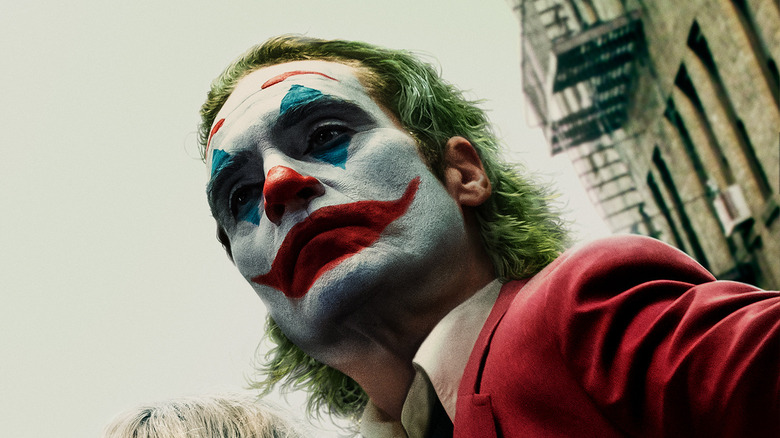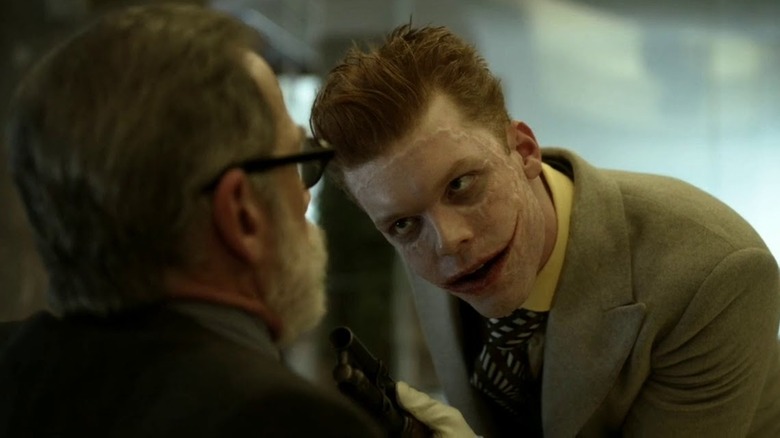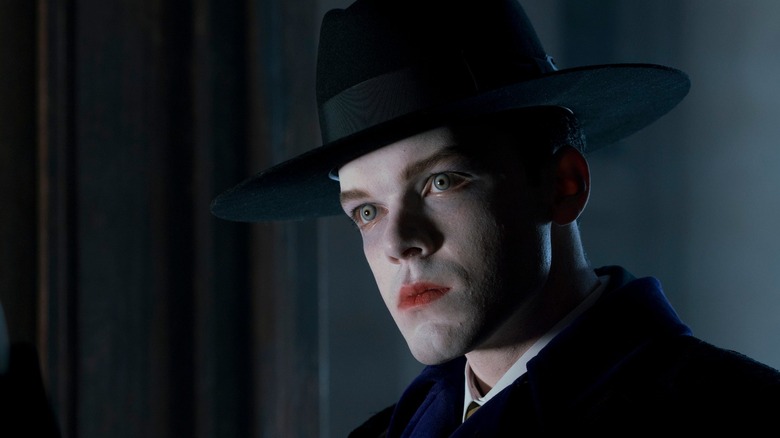Joker 2 Shares A Surprising Similarity With The Batman Prequel Series Gotham
Warning: This article contains spoilers for "Joker: Folie à Deux" and "Gotham."
In Todd Phillips' 2019 "Joker," Arthur Fleck (Joaquin Phoenix) is a nobody, in the sense that he is made to feel that his dreams and hopes amount to nothing, like that of a non-entity. There are some worthwhile layers to this character study, as Arthur is shaped by cyclical abuse and trauma, which he initially attempts to stifle by attempting to make people laugh. However, one bad joke after another escalates into a killing spree, and before he can even process what has happened, he evolves into a symbol of anarchy in Gotham, inadvertently infecting others with his madness. He starts as the Joker, but his life-altering act of infamy morphs the individual into an idea, shared freely among those obsessed with what they think he stands for, creating many who aspire to be Jokers.
Although this idea is merely teased toward the end of Phillips' first film, "Joker: Folie à Deux" leans heavily into this shared identity that reflects the most violent and lawless aspects of what constitutes Gotham. Arthur is still a big deal, his trial being elevated into a spectacle that his followers rush to witness in droves, almost worshipping the cult of personality created as a defense mechanism by an utterly broken, disillusioned man that society had failed on some level.
However, Phillips' takes this idea to its utmost extremes by completely obliterating Fleck's Joker in the film's shocking, baffling ending, where Arthur renounces the existence of Joker as an actual alternate persona and ends up stabbed repeatedly by an inmate who mimics the Joker's laugh, presumably embracing the mantle. He is not the only one obsessed with the mythology surrounding this figure, as Harley Quinn (Lady Gaga) relishes the anarchist fantasy of embracing chaos, and is ultimately disappointed by Arthur's insistence to acknowledge his psychological trauma and true self, as it completely negates this shared dream.
This is not a new idea at all, as something similar and way more fleshed out has occurred in "Gotham," a series that explores some of the most popular villains in Batman's rogue's gallery, even though an adolescent Bruce Wayne (David Mazouz) does not embrace his vigilante status until the series finale (!) of the five-season show. If you've watched even one episode of "Gotham," you will be aware that the tone is deliberately campy and highly stylized, and that anything is possible when it comes to the interpretation of its wide array of comic book-inspired characters, from Oswald Cobblepot to Ra's al Ghul. The series takes a unique approach in revealing its rendition of Joker, without ever using that title, as there were studio-mandated limits on the creative liberties that the series could take.
Gotham pulls off an unconventional bait-and-switch with the Valeska brothers
"Gotham" has some really goofy bits, including plenty of deliberately hilarious scenes with the leads, Jim Gordon (Ben McKenzie) and Harvey Bullock (Donal Logue), and an uncharacteristically no-nonsense, young Alfred (Sean Pertwee) forever ready to beat the heck out of the bad guys. Although thematically inconsistent, "Gotham" isn't meant to be taken too seriously, except for when things get really heavy with the introduction of the proto-Joker, Jerome Valeska (a brilliantly sinister Cameron Monaghan). Raised in a circus, Jerome came into the picture after his mother's gruesome death, and the seemingly traumatized man suddenly reveals himself to be a psychopathic killer incapable of remorse. There's a ruthless edge to this version of Joker, although he is referred to as Jerome throughout, and he thrives at the edge of sanity while relishing the idea of terrorizing Gotham (and literal child Bruce Wayne) because he can.
Although Arthur Fleck did not anticipate his influence over the masses in "Joker", Jerome plans to submerge Gotham into madness with the help of a Laughing Toxin that drives people insane. At the brink of death, Jerome laughs, knowing that his demise will only solidify his mad legacy, creating an army of Jerome Valeskas, who congregate and wreak havoc across the city after their leader's death. Just when you think that this is the end of the arc, we are introduced to Jerome's twin brother, Jeremiah (also Monaghan), who is infected by the Laughing Toxin, which turns his skin pale and his lips crimson, and drives him insane. It is also interesting to note that the series hints that even children were enamored by Jerome's crazed legacy after his death, idolizing his philosophy (or lack thereof), which lays the foundation for one of them to grow up to become the actual Joker.
The Joker-obsessed fanboys in "Folie à Deux" share similarities with the cult-worshipping Jerome in "Gotham," but the latter takes advantage of its structural bandwidth to build upon this idea by introducing many wannabe Jeromes, where one of them goes so far as cutting off Jerome's face from his corpse and wearing it to "become" him. Talk about an idea being as potent as a plague that destroys the very sanctity of moral boundaries.
Gotham takes the idea of Joker as an ideological plague even further
You might be thinking, that must be it for the Joker storyline, as it is already a lot, but you ain't seen nothing yet. Amid Jerome being resurrected by his followers like some sort of Messiah figure, he gleefully returns to further traumatize Bruce (poor kid) and teams up with the likes of Scarecrow and Mr. Freeze. The madness, however, does not die down even after Jerome dies for good. Remember his twin, Jeremiah? Yeah, the saner twin is now infected by madness too, and he's more dangerous than his brother, as his tactics are more cerebral, organized, and driven by the need to punish Bruce Wayne. Jeremiah goes too far, re-enacting Thomas and Martha's shooting with Bruce's loved ones, but he ends up falling into a vat of acid (we're getting there, folks!), which seemingly leaves him brain-dead.
The "Joker" final boss in "Gotham" is post-vat-incident Jeremiah, who takes on the identity of "J" after several years. He tries one last time to break Bruce, becoming completely unhinged and removed from his humanity. By this point, Bruce has finally become the Dark Knight (they never use the term "Batman"), and the two engage in a final battle that ends on an inconclusive note, with J still alive. Although it is unlikely that "Gotham" will ever pick up where it left off, the show's handling of the Joker as an idea that can infect and corrupt minds and create chaos on a systemic level is an interesting one — even though there are some wild, strange swings that push the concept of suspending disbelief as the seasons progress.
Now that Arthur Fleck is dead in "Folie à Deux," it is likely that the idea of the Joker will become more potent than ever, with new players vying to claim the title of the definitive version, who is deserving of all the collective adoration and hatred. Gotham never sits still, as evil morphs constantly within its underbelly, birthing more misguided, disturbed souls itching to make themselves the star deserving of the limelight.


